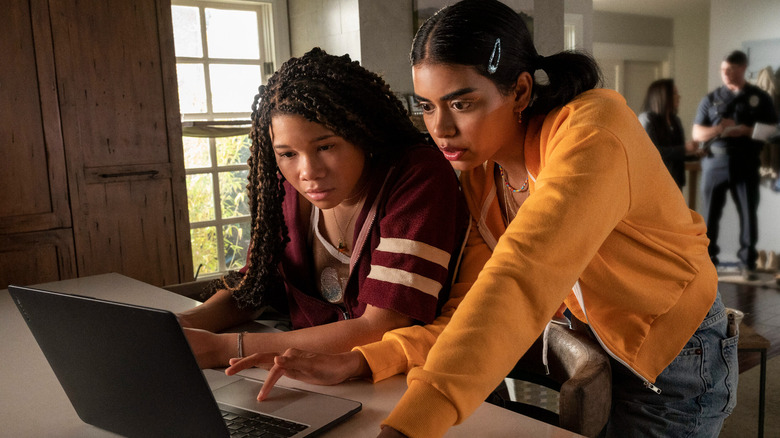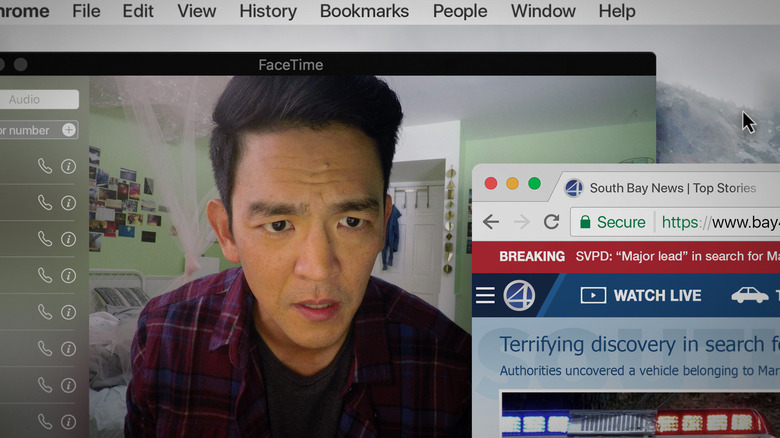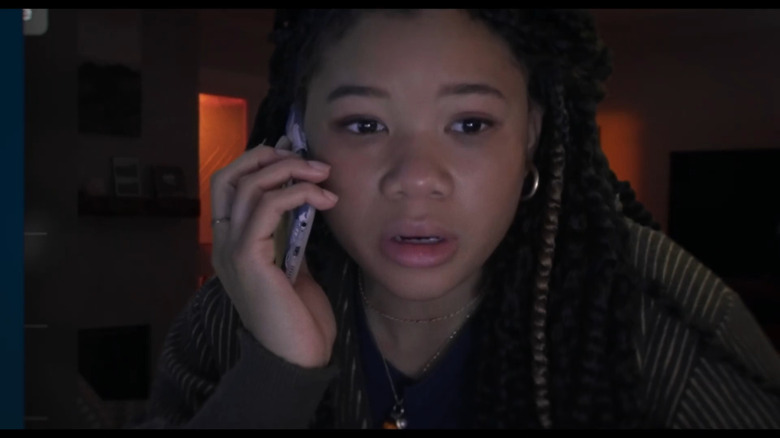Making Movies Like Searching And Missing Is Something 'No Director Wants To Do Twice'
The title of "Missing" pretty much sums it up: this is the story of a missing person, and the family member who puts her all into finding out what happened. The thriller follows Storm Reid's June, a high schooler whose mother goes missing during a Colombian vacation with her boyfriend. Once June realizes that something has gone terribly wrong, she does as any screen-obsessed, digital-age dweller would: harnesses the power of the Internet to track her mother down. And almost entirely through the lens of her various devices, the audience watches it happen.
"Missing" is the latest in a growing collection of screenlife movies, and the second from this particular filmmaking team headed up by Aneesh Chaganty. The John Cho thriller "Searching" came first, following a father's twisty tale of solving his daughter's murder. This time around, Chaganty and co decided to flip the script by focusing on a girl trying to save her mother. But while Chaganty co-wrote and directed the first film, the filmmaker opted to step back and hand the sequel off to first-time filmmakers, Will Merrick and Nick Johnson. So why exactly did Chaganty decide not to direct the sequel? In his own words, "No director who ever makes a movie on a computer screen wants to do it again."
This point made during an interview with Cinema Daily isn't a slam of the screenlife subgenre, which Chaganty very much champions. It's a commentary on how insanely complicated it is to actually pull one of these movies off.
'This movie is so much work and headache to make'
Looking in from the outside, you might assume that making a screenlife movie means taking the simple route: after all, these computer screen-set horror flicks tend to be much cheaper and filming a screen suns a lot less complicated than pulling off an elaborate action scene. But while making "Searching," Chaganty had to endure some pretty grueling work. The filmmaker has since revealed that the 2018 film was shot in 14 days, but took a year and a half to edit. As for "Missing," Chaganty explained:
"This movie is so much work and headache to make. People sometimes think this movie is so easy to make — no, it's not. This is like, four years in front of every frame is created, every part of the frame is created, on Photoshop and Illustrator, InDesign and After Effects, and rendered. We add color, and we add lens flares and lens blurs and camera shake. It's so much work."
The worlds of "Searching" and "Missing" are not merely comprised of Skype calls and text messages: the screens are extremely active. Beyond the protagonists' activity, there's always a lot more for the audience to catch sight of. Headlines, screen names, social media posts, entire subplots, and graphics are used to flesh out the world, which gives the filmmakers a lot more to worry about controlling.
It also gives them a lot more power over the final edit, but in a way, that only serves to make things more complicated too. Says Chaganty, "At any moment you can go 'Ah, maybe there's another tech that we need, another scene that we need.' It's constant experimentation, and you end up working on this movie for — it feels like your whole life."
A filmmaker's work is never done
For a screenlife movie, the job doesn't stop at recording a physical performance. There's more to each scene than what the actors are doing. What the characters do on the screen — with the mouse, through their typing, and what they react to — is something that can be altered in the editing process. It can be tweaked for timing, or overhauled entirely when it comes to images and text. Meaning more so than other films — where reshooting would be a whole process — the filmmakers can make changes at any given stage. And if they keep editing, then the film is never done. Or at least that's what it starts to feel like, according to Chaganty:
"There's a sense of exhaustion that comes with making a movie like this that no director wants to do twice. So immediately when the opportunity that we were making a sequel or follow-up came up, I was like, we're giving this movie to another group of filmmakers who knows exactly what they're doing."
Opting out of the director's chair, Chaganty turned to collaborators Will Merrick and Nick Johnson, who edited the first film. "I've known them since film school," Chaganty said. "It was a no-brainer to us to have them direct and write the movie." Chaganty and Sev Ohanian (who co-wrote the first film) returned to produce and help craft the story but writing and directing fell to Merrick and Johnson. The team was back together but in different roles. "We all just played musical chairs and switched seats, and continued to make a sequel," Chaganty said.
In the best possible way, this shows in the final project: "Missing" is very self-assured, taking what worked about "Searching" and delving deeper with the twists and subversions. Hopefully, that experience also meant a shorter stay in the editing bay.


